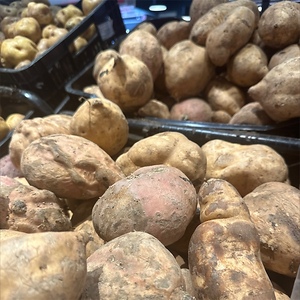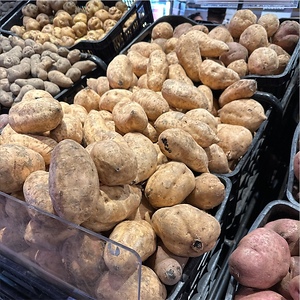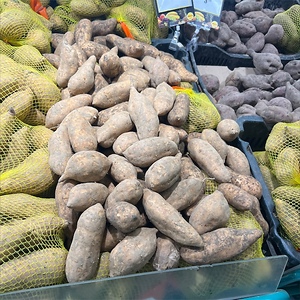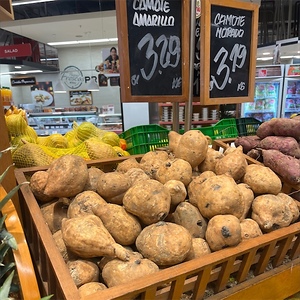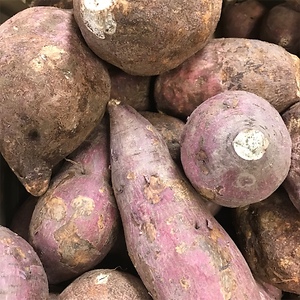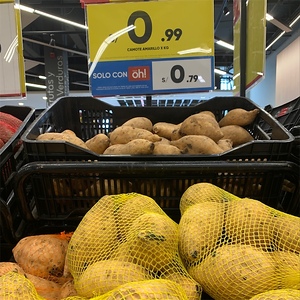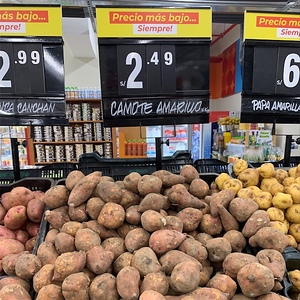


Yellow Camotes
Estimated Inventory, lb : 0
Description/Taste
Yellow Camotes can be found in multiple sizes and shapes, depending on growing conditions and the specific variety, and generally averages between 7 and 22 centimeters in length. The tubers can appear in distinct oblong, oval, or cylindrical shapes, and some may be curved or straight with tapered or blunt ends. Yellow Camotes are uniform or irregular in nature, and the skin is typically rough, firm, taut, and textured. In Central and South American markets, Yellow Camotes are often sold with a layer of soil still covering the skin, giving the tubers a darker-hued coloring. Once cleaned, the tuber’s skin ranges from light brown, tan, to red-brown with some darker-colored markings. Underneath the surface, the yellow-orange flesh is solid, dense, dry, and firm when raw, becoming soft, tender, and creamy when cooked. Yellow Camotes are not edible raw and must be cooked. The cooked tubers often have a high sugar content, allowing the flesh to develop a rich, sweet, sugary, and savory taste.
Seasons/Availability
Yellow Camotes are available year-round, with a peak season in the late fall through winter.
Current Facts
Yellow Camote, botanically classified as Ipomoea batatas, is a general descriptor for tubers belonging to the Convolvulaceae family. The name Camote is derived from the Nahuatl word “camotli,” a term used throughout Central and South America for varieties of sweet potatoes. Nahuatl is an indigenous language spoken throughout the Americas for thousands of years, especially in Central Mexico. Like the sweet potato’s long history, the name Camote has widely spread and become a commonly used name for the species. Yellow Camote refers to sweet potato cultivars that exhibit yellow-orange flesh, and there are many other categories of Camote, including purple, white, and red-fleshed tubers. Yellow Camote is extensively grown and sold worldwide under other names, but they are notably cultivated and consumed in Central and South America, notably Peru. Camotes, in general, are a favored crop as they are easy to grow, highly productive, and can be cultivated without the need for aggressive pesticides. The entire plant can also be harvested, the tubers used for culinary purposes, and the leaves and stems fed to livestock. Yellow Camote is a common commercial item in markets and is a versatile culinary ingredient utilized and cooked in a wide array of sweet or savory dishes. In some regions of the Americas, including Peru, the tubers are cultivated for commercial export and are also sold for processing into frozen goods.
Nutritional Value
Yellow Camotes are a source of fiber to regulate the digestive tract, potassium to balance fluid levels within the body, vitamin E to guard the cells against the damage caused by free radicals, and vitamin C to strengthen the immune system. Sweet potatoes, in general, also provide beta-carotene, which is converted into vitamin A in the body to maintain healthy organs, iron to develop the protein hemoglobin for oxygen transport through the bloodstream, magnesium to control nerve functions, calcium to protect bones and teeth, and other nutrients, including folate, phosphorus, thiamine, riboflavin, and niacin. Camote has been used in natural medicines throughout South America as a gentle digestive aid. The tubers are also thought to contain antioxidant and anti-inflammatory properties and are topically used against irritations and insect bites.
Applications
Yellow Camotes have a mild, sweet, and subtly nutty flavor suited for cooked preparations. The tubers cannot be consumed raw and must be cooked before they are edible. Yellow Camote is common in recipes throughout Central and South America, and the tubers are often boiled, steamed, roasted, or fried. The creamy flesh is popularly mashed and served as a simple side dish, sliced into thin pieces and fried, or pureed and used as a thick base layer for roasted meats and vegetables. In Peru, Yellow Camote is famously fried and served with chicharrones, especially on Chicharrón Day, a gastronomic celebration annually held on the third Saturday in June. Yellow Camotes are also cooked and added to ceviche, mixed into grain-based dishes, or roasted in underground ovens in the Andes Mountains in a traditional preparation known as Pachamanca. In other regions of South America, Yellow Camote is added to soups and stews as a thick, tender, and filling ingredient. The tubers are also simply boiled or steamed and served with herbs and meats. It is important to note that Yellow Camote, meaning sweet potato, is utilized worldwide, and there are many different preparations using the species. Yellow Camotes pair well with herbs such as cilantro, thyme, and rosemary, spices including paprika, cumin, and chili powder, and meats such as beef, pork, and poultry. Whole, unwashed tubers will keep for several weeks to months when stored in a cool and dry location.
Ethnic/Cultural Info
Yellow Camotes are famously incorporated in picarones, one of the most popular desserts in Peru. The dough-based, ringed fritters are savored for their crisp exterior and fluffy interior, and Camotes are a primary ingredient included in the dough. It is thought that picarones are a dessert that evolved from pre-Columbian dishes. Squash and sweet potatoes were prevalent crops grown in Peru and were often fried in culinary preparations. With the arrival of the Spanish, ancient recipes evolved from introducing ingredients such as sugar, milk, and flour, and new recipes were created to reflect the changing culture. Picarones are inspired by the Spanish fritter known as buñuelos. Afro-Peruvian influences also shaped the dessert, especially using chancaca to make a sugary sauce poured over the fritters. Picarones are widely available throughout Peru in the modern day and are offered through restaurants, street vendors, and markets. The dessert is also served for special occasions and is a festive addition to religious processions, birthdays, weddings, and community parties.
Geography/History
Yellow Camotes are believed to be native to South America and have been growing wild since ancient times. Camote is a term used in Central and South America for tubers belonging to the species Ipomoea batatas. The exact origins of Ipomoea batatas is unknown, as several reported theories connect the species to various wild ancestors. Scientists and historians often reference Peru as being a possible site of origin. Archeological remains of Camote have been discovered from the pre-Columbian settlement of Huaca Prieta, dating to around 3,500 to 1,800 BCE, and several other sites in Peru have held evidence that the tubers have been present in culinary and medicinal uses for thousands of years. Regardless of the multiple origination theories throughout South America, Camotes or Sweet Potatoes, in general, were domesticated and extensively cultivated to develop tubers improved varieties for medicinal and culinary purposes. As the tubers were being selectively bred, they were also spread throughout the Americas, reaching Mexico and Central America. Yellow Camote was also introduced worldwide by Spanish and Portuguese explorers who carried tubers to Europe and Asia. In Peru, Yellow Camotes are cultivated for domestic sale in local markets and are also grown for export on a small scale. The species is planted in regions of the jungle, coast, and mountains from sea levels to 2,500 meters in elevation. Various Camote varieties were also examined through the International Potato Center, or CIP, beginning in 1986 to improve cultivars for countrywide production. The National Institute of Agrarian Research, or INIA, also established a sweet potato breeding program in 1991 in partnership with the International Potato Center. The joint efforts produced several new sweet potato varieties, including INIA 306, INIA 100, Huamnachero, Imperial INIA, and Cañetano, and these tubers are sold commercially throughout Peru. Yellow Camotes are cultivated in regions across Peru, with the highest production occurring in the department of Lima. Today, Yellow Camotes are cultivated worldwide under varying names and are sold fresh in local markets for culinary use. The Yellow Camotes featured in the photograph above were sourced through markets in Lima, Peru.
Recipe Ideas
Recipes that include Yellow Camotes. One



